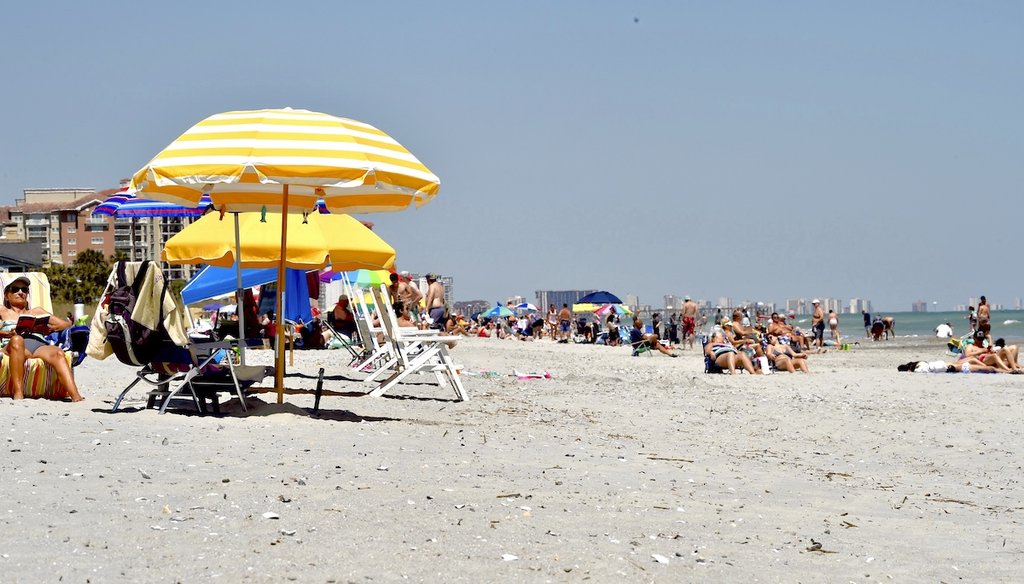Stand up for the facts!
Our only agenda is to publish the truth so you can be an informed participant in democracy.
We need your help.
I would like to contribute

Visitors sit on the sand on Myrtle Beach, S.C., on May 2, 2020, amid the continuing coronavirus outbreak. (AP/Kinnard)
If Your Time is short
-
Neighboring states might not set out to reopen in tandem, but between commuters flowing back and forth, and businesses competing for customers, they can end up in the same place.
-
By April 20, South Carolina was reopening businesses. It took about three weeks for North Carolina to follow.
-
The disease numbers for cases and tests matter, but they far from dictate policy.
More than other towns along North Carolina’s shore, Carolina Beach relies on the hotel and bed and breakfast trade. In summer, its population swells from about 7,000 to nearly 30,000.
So it was no small matter in late March when town leaders closed the beach and shut down short-term rentals to stop the spread of the novel coronavirus.
"We told people, ‘Don’t come here,’" said town manager Bruce Oakley. "‘We are sheltering in place and you should do the same.’"
Carolina Beach sits in New Hanover County, which has been less affected by the virus than other parts of the state. Out of about 234,000 people in the county, there have been three deaths from COVID-19 and 97 confirmed cases.
About an hour’s drive south lie the beaches of South Carolina. A month after banning short-term rentals, Myrtle Beach and other towns in Horry County, S.C., lifted restrictions, because, as one local official said, it was time to "get the economy back up and running for the residents."
Sign up for PolitiFact texts
Horry County’s COVID-19 numbers are less promising than those of their near neighbors to the north. The county, home to about 354,000 people, has seen 18 deaths.
The new rules in South Carolina at Myrtle Beach set off a domino effect in North Carolina.
Soon after Myrtle Beach shifted, North Carolina beach towns right on the border began dropping their short-term rental bans, and less than two weeks later, Carolina Beach followed suit.
As each state decides how far and how quickly to dial back COVID-19 stay-at-home orders, what happened along this stretch of the Atlantic coast illustrates what every governor knows — their decisions don’t take place in a vacuum.
"We are concerned about what happens in other states because the virus doesn’t respect state boundaries," North Carolina Gov. Roy Cooper said May 5.
Some states aim to work in tandem with their neighbors. But anywhere that states share a long border and business flows back and forth, alignment may come regardless of any formal pact. Add a dose of competition for customers, and the odds go even higher.
North Carolina implemented its stay-at-home order a week earlier than South Carolina, and has been slower to roll back restrictions. But at this point, the states’ approaches are converging.
In theory, trends for cases, hospitalization, testing and other health measures would drive reopening decisions. In practice, they are one factor among others.
The White House guidance for states on dialing back stay-at-home orders includes a few benchmarks. One signal is a 14-day decline in new cases, measured in a raw count or as a fraction of positive test results. Another was ensuring there would be enough intensive care beds to handle a surge.
South Carolina Gov. Henry McMaster said he didn’t feel bound by everything on the White House list.
"Those are guidelines," McMaster, a Republican, said April 20. "That’s not the law. ... We have information here from our professionals here in South Carolina as well and we go by that as well."
North Carolina originally said it would relax social distancing orders when it saw level or declining trends for cases and hospitalizations. It wanted 5,000 to 7,000 tests per day, 500 contact tracers and enough personal protection equipment to meet every need for 30 days.
The state reached its goals on some measures, such as hospitalizations, and not others, as confirmed cases are still rising. It aimed to have enough personal protection equipment for every medical professional who needed it, but said it is "working to ensure" an adequate supply. The state moved ahead with unwinding restrictions regardless.
"This is a careful and deliberate first step, guided by the data, and North Carolinians still must use caution while this virus is circulating," said Cooper, a Democrat.
Neither state has seen a steady decline in the number of new cases per 100,000 people.
The more encouraging trend is in the percent of positive cases out of all tests performed. South Carolina might have a higher fraction of people testing positive, but the fraction of positive test results is falling. In North Carolina, the trend is not as pronounced.
State leaders say that while social distancing precautions need to stay, people want to go back to work. So they’ve started lifting restrictions and preparing for a phased re-opening.
South Carolina made the first move. April 20, McMaster allowed certain non-essential retail stores to reopen. Then, he lifted the state’s "work-or-home" order that limited travel to work, family visits and essential activities. He also rescinded several orders he put in place to prevent tourists from New York, New Jersey and other so-called hot spots from spreading the coronavirus.
Restaurants can serve meals outside. Local authorities can open public beaches.
"This virus will continue to spread and still presents a very real and serious threat to our people, but I believe in South Carolinians and their ability to act wisely and safely," McMaster said May 1.
Broad changes came a little slower in North Carolina. Cooper announced that the state would transition May 8 to the first phase of a weeks-long, three-part reopening plan.
The new modifications will allow more businesses, childcare facilities, hotels and parks to open with some limitations. Gyms, barber shops, theaters and the like will remain closed, while restaurants will stick to take-out and delivery services.
For now, North Carolina’s stay-at-home order remains, but exceptions are plentiful and set to multiply once the state enters its second phase.
On a typical day, over 175,000 cars pack Interstate 77 to cross the border between York County, S.C., and the metro area that includes Charlotte, N.C.
Residents here share life between two states. Charlotte gives South Carolinians many reasons to head north: office jobs and softball leagues and health care. The Charlotte metro area includes three South Carolina counties, and hospitals in Mecklenburg County, home to Charlotte, serve patients from all over.
With social distancing rules differing between the two states, people on both sides of the border choose the path of least resistance.
"When certain restrictions would apply to North Carolina or Mecklenburg County but were not in place in South Carolina, we would see a lot of North Carolina visitors," said Chuck Haynes, emergency management chief for York County. "And as South Carolina started ramping up its restrictions, our folks would go to North Carolina to have a little freedom."
Haynes says as the rules change again, I-77 presents an inescapable risk. The case rate in Mecklenburg is 170 per 100,000, twice as high as York’s. Mecklenburg has 58 deaths; York has five.
"That’s an avenue for daily migration of the virus, so yes, of course that concerns us," Haynes said. "But we know the economy is important and that opening up is important for mental health. The risk is part of the benefit and we acknowledge that."
That pragmatic view prevails, even as no one argues that the more people move around, the more the virus spreads.
Cody Hand with the North Carolina Healthcare Association said hospitals have accepted that transmission across the border is "frankly, not in our control."
A safe reopening strategy in both states hinges on increased testing, contact tracing and the resources to isolate people who test positive.
Health professionals in both states say those resources fall short. But if that’s the case, then the goal, they say, should be to spot outbreaks and pivot quickly to stem them.
"I think if we expect perfect, it’s just not achievable," said physician David Cole, president of the Medical University of South Carolina. "We have to reach an imperfect balance where good is good enough."
Where that balance lies is unclear. And how much testing, tracing and resources to help infected people isolate will be enough is also unknown.
In Carolina Beach, the town initially took small steps to dial back limits. After Cooper announced an easing, and other beach communities reopened rentals, the town saw little reason to hold out.
"The mayor and council felt if he was lightening his up, we probably shouldn’t keep in place rules that were more restrictive than his original orders," Oakley, the town manager, said.
Oakley told us local businesses have supported restrictions all along. But it would be hard to survive when towns a short drive away stopped telling tourists to stay home.
Our Sources
Myrtlebeachonline, Horry County hotels, campgrounds to re-open this week as coronavirus restrictions expire, April 28, 2020
MyrtleBeachonline, North Myrtle Beach to open hotels, short-term rentals following coronavirus shutdown, April 29, 2020
South Carolina Department of Transportation, Average daily traffic for York County, Feb. 19, 2020
Spectrum News, Increasing Testing and Decreasing Restrictions, April 27, 2020
Kaiser Family Foundation, State Data and Policy Actions to Address Coronavirus, April 27, 2020
South Carolina Department of Health and Environmental Control, Testing Data & Projections, accessed May 5, 2020
Covid Tracking Project, State data, accessed May 6, 2020
USAFacts, Coronavirus locations, accessed May 6, 2020
U.S. Centers for Disease Control and Prevention, COVID data tracker, accessed May 4, 2020
White House Opening up America again, April 16, 2020
WIS News 10, McMaster, state officials discuss plan to reopen S.C. at accelerateSC meeting, April 27, 2020
Johns Hopkins University, Coronavirus Resource Center, accessed May 6, 2020
North Carolina Governor’s Office, Governor Cooper Announces Modified Stay At Home Order and Transition to Phase 1 of Easing Restrictions, May 5, 2020
South Carolina Governor’s Office, Gov. Henry McMaster to Lift "Work-or-Home" Order , May 1, 2020
U.S. Centers for Disease Control and Prevention, Contact Tracing, April 29, 2020
State of North Carolina, Staying Ahead of the Curve, accessed May 6, 2020
South Carolina Chamber of Commerce, SC Chamber President & CEO Ted Pitts To Serve on Governor’s Accelerate SC Task Force, April 20, 2020
North Carolina Chamber of Commerce, Aligning Health Policy and Business, April 30, 2020
State of South Carolina, accelerateSC, April 28, 2020
National Association of County and City Health Officials, Building COVID-19 Contact Tracing Capacity in Health Departments to Support Reopening American Society Safely, April 16, 2020
North Carolina Chamber of Commerce, Shelter in Place Should be a Last-Ditch Resort: North Carolina Must Instead Draw on Decades of Experience, March 21, 2020
North Carolina Chamber of Commerce, North Carolina Issues Stay-at-Home Order, March 27, 2020
WRAL-TV on Facebook, May 5, 2020
North Carolina Governor’s Office, Staying Ahead of the Curve, accessed May 6, 2020
North Carolina Governor’s Office, COVID-19 North Carolina Dashboard, accessed May 6, 2020
UNC-TV on YouTube, Coronavirus Briefing: NC Gov. Roy Cooper (04/28/20), April 28, 2020
North Carolina Governor’s Office, NCDHHS Announces Carolina Community Tracing Collaborative, April 27, 2020
North Carolina Governor’s Office, Governor Cooper, State Education Leaders: Remote Learning To Continue Through End of 2019-2020 School Year, April 24, 2020
North Carolina Governor’s Office, Governor Extends Stay At Home Order Through May 8, Plans Three Phase Lifting of Restrictions Based on Virus Trends, April 23, 2020
North Carolina Chamber of Commerce, North Carolina’s Road to Reopening: Aligning Health Policy and Business, May 1, 2020
YouTube, WSAV3: AccelerateSC meets to discuss plans for reopening economy | Part 1; AccelerateSC meets to discuss plans for reopening economy | Part 2, May 5, 2020
Email interview, Brian Symmes, South Carolina Gov. Henry McMaster’s communications director, April 28, 2020
Phone interview with Cody Hand, senior vice president of advocacy and policy and deputy general counsel at the North Carolina Healthcare Association, April 28, 2020
Email interview with Amy Ellis, public information specialist at the North Carolina Department of Health and Human Services, April 28, 2020
Statement from Novant Health, April 30, 2020
Statement from the Mecklenburg County Public Health Department, April 30, 2020
Interview, Bruce Oakley, town manager, Carolina Beach, May 5, 2020
Interview, Lisa Brown, public health preparedness coordinator, New Hanover County, N.C., May 4, 2020
Interview, Hilary Campbell, research associate, Margolis Center for Health Policy, Duke University, May 4, 2020
Interview, Michael Schmidt, professor of immunology, Medical University of South Carolina, april 28, 2020
Interview, Pia MacDonald, senior epidemiologist, RTI International, May 5, 2020
Email exchange, Brian Symmes, spokesman, South Carolina governor’s office,
Phone Interview, Chuck Haynes, emergency management director, York County, SC, April 29, 2020














































